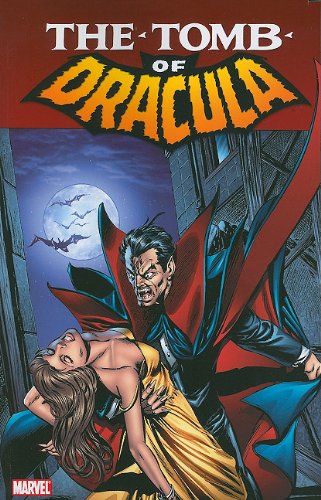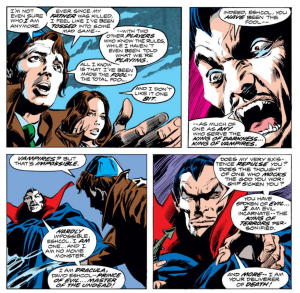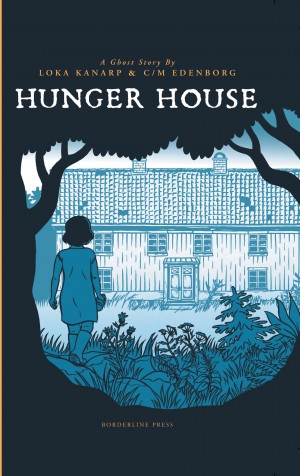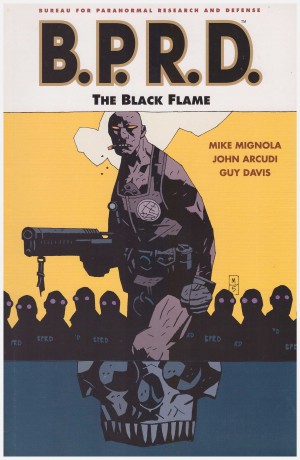Review by Graham Johnstone
This is the third of Marvel’s colour paperback reprints of their classic Tomb of Dracula series and related titles. Story and particularly art on this title was among the best of its era and still impresses today. Stories included from companion titles, however, are not of the same standard.
Tomb of Dracula picks up from Bram Stoker’s book, with Dracula resurrected in the ‘present day’, i.e. the 1970s. The preceding volumes established a team of vampire hunters, including descendents of Stoker’s characters, and Blade, later a film franchise. As this volume starts they believe Dracula dead, and take time apart to resolve personal matters, coming to a head by the end of this volume.
This enables writer Marv Wolfman to introduce new characters: Hannibal King who investigates others, while keeping his own dark secret, and David Eschol, drawn into a dangerous world when his father assembles the lost parts of a legendary Chimera statue. The focus of these stories is mostly on how Dracula’s agenda affects the other characters. We also see his more human side, particularly through his relationship with the vulnerable Sheila Whittier, and a blind child in later story, but he can’t understand why they don’t respond the way he wants them to.
While previous volumes moved around Europe these stories are set in and around London. It starts and finishes in the vicinity of the Houses of Parliament, where Dracula tries to extend his influence in favour of vampires. This both pre-empted the vampire politicians in TV’s True Blood, and also seems strangely topical in 2015 with a current focus on who those in power serve, and allegations of secrets and scandals.
Gene Colan drew every issue of Tomb, and it’s hard to imagine it by anyone else. It combines his trademark dizzying action scenes, with gothic atmosphere and vivid locales. Inker Tom Palmer renders this impeccably in fluid lines and velvety black shadows. Palmer also coloured most of these stories, achieving impressive subtlety despite the cheap paper and printing. This volume recreates the original colouring fairly successfully. His palettes range from twilight blues, purples, and vermilions, to autumnal browns, or electric, acid yellows. The colour adds coherence to Colan’s complex layouts. Modern colourists could learn a lot.
Marvel’s approach to collating reprint volumes is to include related stories from other titles, in the order they were published. In principle this makes sense, but more than a third of this content is drawn from a companion title. These stories, by Chris Claremont and David Kraft are fairly literate and in the spirit of the Wolfman stories, but occur mostly in the past and feature different supporting characters. This avoids continuity issues, but also means they don’t impact on the main narrative, and so might have been better collected in a separate volume. The art on these is by Don Heck, a competent storyteller who lacks finesse. He has a set of stock poses and facial expressions, and alongside Colan/Palmer his pages look noticeably poor. Without these stories this volume would have rated higher.
This is a ‘mid-range’ edition. These stories are also collected in volume two of the cheaper black and white Essential Tomb of Dracula, and the first of the dearer Omnibus editions.
These stories were not conceived as a single volume, and it leaves cliffhangers in the stories of Taj Nital in India, and Frank Drake in South Africa. No further volumes have appeared since 2011, but the story can be picked up in the other editions.





